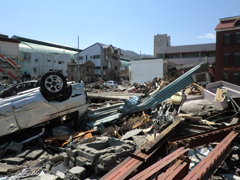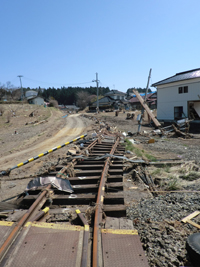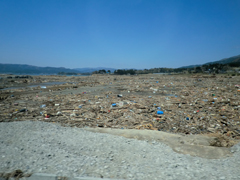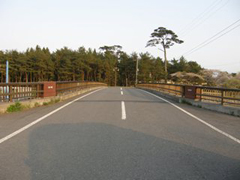Top>Opinion>The Great East Japan Earthquake: Rikuzentakata Restoration of the City and Support for It
 Index
Index

Masayoshi Tanishita [Profile]
The Great East Japan Earthquake: Rikuzentakata Restoration of the City and Support for It
Masayoshi Tanishita
Professor, Faculty of Science and Engineering, Chuo University
Areas of specialization: Urban Engineering, Quantitative Spatial Analysis
On the evening of March 11, when I was driving a car after hearing an interesting story at Buna No Mori (Japanese beech forest), a company in Noto working on the regeneration of farming and mountain villages, there was a phone call from my parents living in Ishilkawa prefecture, saying, "You know what? There's something terrible happening in Tohoku and Tokyo." I immediately called my home in Saitama, but could not get through. I later learned that my family was safe by email. That night, at the house of Mr.&Mrs. Ogino of Maruyama Gumi, located in Mii, Wajima-shi, I witnessed the shocking images of the Great East Japan Earthquake.
I worried if Mr. Hiroki Kanno in Rikuzentakata was all right. I got to know him at the Mottainee Forum held at Mori to Kaze no Gakko (school of forest and wind) in Kuzumaki-machi, Iwate prefecture in 2004, and since then we have kept in touch with each other. After acquiring survival information through Google Person Finder, I sent him an e-mail. Mr. Kanno's house is far from the ocean, and fortunately they escaped the damage. As a member of a fire fighting brigade, he had been engaging in lifesaving and debris-clearing activities since immediately after the disaster. Means of telecommunications were lost, and it was two weeks later that I received a reply from him.
"Is there anything you need?" "Goods have started arriving. I need your counsel." Since then, I started asking myself what I can do.
In this article, taking the case of Rikuzentakata as example, I would like to point out the characteristics of the Great East Japan Earthquake in comparison with the Great Hanshin Earthquake, and to present issues to be addressed regarding the restoration of land, home, and town.
Three differences from the Great Hanshin Earthquake
First of all, there is a difference in scale. The Great East Japan Earthquake has caused diverse effects on a wide range of areas from Hokkaido to Kanagawa, Nagano, and Niigata. In municipalities like Rikuzentakata where the public office was located in lowland area, many employees lost their lives and administrative functions were significantly impaired.

Kamaishi, April 17
Secondly, in this disaster, most of the damage was caused by the tsunamis and by the nuclear power plant. It is true that the disaster has inflicted damage on the grounds and buildings in inland areas in no small way, but the affected areas were limited. If you drive to Rikuzentakata from Ichinoseki, you would be speechless as the scenery of the town that looks as if nothing has happened suddenly changes and the scenery of heaps of debris jumps into your sight. Meanwhile, around the Fukushima Daiichi Nuclear Power Plant, there is still land that is inaccessible.

Rikuzentakata, April 17
The third difference, which I think is the biggest, is that it is the primary industries that have sustained the afflicted area. There had been a projection that the population in Rikuzentakata would become two-thirds of that of today by 2030, but the disaster hastened the decline by about five years. It is required to provide people with hope by generating employment through industrial clustering based on agriculture, forestry, and fishery industries.
Issues to be addressed and proposals regarding restoration of land, home, and town

Rikuzentakata, April 17
(1)Land
Vast amount of lands are now below sea level, cannot be accessed because of the nuclear power plant, and the owners no longer occupy them. The problem is how to administer these lands, which are not easily restorable. This is a major issue stretching across the fields of law, economics, and technology.
(2)Home
For the first time in Japan since the disaster, a measure has been taken that deems non-public rental housing as temporary housing. Also, many temporary houses have been built not only in public areas but also in private areas. Detached temporary houses were built by local workers in Sumita-cho, using lumber from the town.
The points at issue are the maintenance of communities that have been nurtured with traditional agricultural and fishing industries, and emotional care. Selecting temporary housing tenants by drawing lots will lead to the fragmentation of communities. A change of environment can cause significant stress among children and the elderly. In Nagahora district in Rikuzentakata, temporary houses for the people who suffered within the community were built on private land acquired in the name of the community, which maintained its existence. (The houses are, however, prefabricated, against the wishes of the community.) Also, to prevent solitary deaths, measures such as providing supporters who make the rounds of houses, conversation rooms, and meeting places are about to be implemented. We are proposing car sharing, from the idea that providing a means of transport, shopping, playing, and meeting friends and acquaintances will all lead to emotional care. We think it would be better to reduce parking spaces and create common spaces such as coffee shops and public baths by sharing cars, keeping the system of Yui, communal group work.
(3)Town
It is required to present what scenario we should create to provide hope for those living in the afflicted area, as concretely as possible.

Takada before the disaster (photo by Masashi Watanabe)
Rikuzentakata has the largest sandy beach and plains on the Sanriku coast where the Kesen River flows into Hirota Bay. Takatamatsubara, a pine woods along the coastline planted by local people in the early Edo period and passed on generation to generation since then, had been a symbol of the area as the Shonan of Iwate, but it has been uprooted by the tsunamis. The highway, which has been nurtured with the history of the area, has also turned into a field of debris. Based on the Green Infrastructure concept, we are proposing a road map in which debris will be utilized to restore Takatamatsubara and to build a super levee on Kesen River, for the regeneration of the basic structure of nature in the area and for disaster prevention. In addition, temporary urban areas should be built immediately along the historic highway in the foothills, and through which the basis of life and production and the face (character) of the town should be restored.
Difficulty of logistical support
What I thought after receiving the reply from Mr. Kanno is to do support activities making a team. I visited Rikuzentakata four times and had multiple meetings in Tokyo with scholars from Meiji University, the University of Tokyo, and Hosei University, a professor emeritus at Chiba University, a concurrent lecturer at Chuo University, as well as business persons such as consultants and company managers. We had talks with the people living there, and an NPO has been established on the grounds that an organization is necessary for citizens to discuss urgent issues and carry out activities (create jobs) in the current situation where the government cannot provide sufficient services. Meanwhile, it is also necessary to communicate information about what the town should be in the future from a long-term perspective and to make appeals to the government. Logistical support means two roles-in other words, to stand close and to speak up actively. The difficulty I am now feeling is how to balance these two roles. Simply following the moves of the government or local people is not the work that experts should do, but it is fundamentally wrong to force people in the area to follow what we do.
Sticking to the attitude of learning from local areas, as in the cases of regeneration of farming and mountain villages, I would like to do long-term support that brings out the creativity and energy of the people living in the area.
※In this fall, Crescent Academy, Chuo University will offer a course tentatively titled Learning from the Great East Japan Earthquake Disaster: An approach from the Department of Civil and Environmental Engineering, staffed mainly by faculties on the Department of Civil and Environmental Engineering.
(Note)
Green Infrastructure: Green Infrastructure comprises the green land resources such as forests, agricultural lands, and greeneries that contribute to the development of primary industries and to the maintenance of ecosystem, as well as the nature friendly urban infrastructures such as disaster prevention and energy that contribute to the urban economy. The term refers to the infrastructure, which is reciprocally networked by rivers, ocean, and highways, and calls in investments for new economic activity while retaining various functions such as health promotion and weather mitigation (Yoritaka Tashiro/Goroumaru Tsujino).
- Masayoshi Tanishita
Professor, Faculty of Science and Engineering, Chuo University
Areas of specialization: Urban Engineering, Quantitative Spatial Analysis - Professor Tanishita was born in Ishikawa Prefecture in 1967. He withdrew from the Doctoral Course, School of Engineering, the University of Tokyo, in 1992. He became a Professor in 2008, on the Faculty of Science and Engineering, Chuo University, after assuming the positions of Associate Researcher at the University of Tokyo, Full-Time Lecturer in School of Engineering, at the University of Tokyo, Full-Time Lecturer, Assistant Professor and Associate Professor on the Faculty of Science and Engineering, Chuo University. Area of specialization: Urban Engineering, Quantitative Spatial Analysis Current areas of research: the external costs of automobiles and related tax systems, effects of regional planning and building agreement on the real estate market, physiological evaluation of walking space, management organization of public space, and the like.
- Research Activities as a Member of Research Fellowship for Young Scientists (DC1), Japan Society for the Promotion of Science (JSPS) Shuma Tsurumi
- Important Factors for Innovation in Payment Services Nobuhiko Sugiura
- Beyond the Concepts of Fellow Citizens and Foreigners— To Achieve SDGs Goal 10 “Reduce Inequality Within and Among Countries” Rika Lee
- Diary of Struggles in Cambodia Fumie Fukuoka
- How Can We Measure Learning Ability?
—Analysis of a Competency Self-Assessment Questionnaire— Yu Saito / Yoko Neha - The Making of the Movie Kirakira Megane








